
The Ixodidae are the family of hard ticks or scale ticks, one of the three families of ticks, consisting of over 700 species. They are known as 'hard ticks' because they have a scutum or hard shield, which the other major family of ticks, the 'soft ticks' (Argasidae), lack. They are ectoparasites of a wide range of host species, and some are vectors of pathogens that can cause human disease.

Ixodes is a genus of hard-bodied ticks. It includes important disease vectors of animals and humans, and some species inject toxins that can cause paralysis. Some ticks in this genus may transmit the pathogenic bacterium Borrelia burgdorferi responsible for causing Lyme disease. Additional organisms that may be transmitted by Ixodes are parasites from the genus Babesia, which cause babesiosis, and bacteria from the related genus Anaplasma, which cause anaplasmosis.

Amblyomma is a genus of hard ticks. Some are disease vectors, for example the Rocky Mountain spotted fever in United States or ehrlichiosis in Brazil.
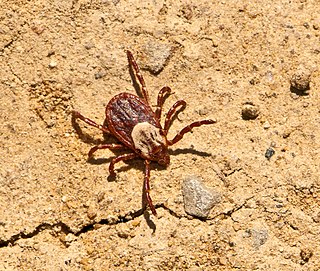
Dermacentor is a genus of ticks in the family Ixodidae, the hard ticks. The genus has a cosmopolitan distribution, with native species on all continents except Australia. Most are found in North America.
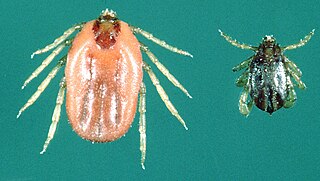
The Asian blue tick is an economically important tick that parasitises a variety of livestock and wild mammal species, especially cattle, on which it is the most economically significant ectoparasite in the world. It is known as the Australian cattle tick, southern cattle tick, Cuban tick, Madagascar blue tick, and Puerto Rican Texas fever tick.

Haemaphysalis is a genus of ticks, containing these species:
Jane Brotherton Walker was a Kenyan-South African scholar in the field of tick taxonomy, particularly in Africa.
Rhipicephalus hoogstraali is a tick found in Djibouti and Somalia. First recognized by Harry Hoogstraal as Rhipicephalus longicoxatus based on an incomplete published description, after discovery of the holotype of R. longicoxatus, it was described and named to honor Hoogstraal in 2009.

Hyalomma dromedarii is a species of hard-bodied ticks belonging to the family Ixodidae.
Haemaphysalis bispinosa is a hard-bodied tick of the genus Haemaphysalis. It is found in India, Sri Lanka, Myanmar, Pakistan, Nepal, Australia, and Indonesia. It is an obligate ectoparasite of mammals. It is a potential vector of Kyasanur Forest disease virus. These ticks was found parasitized by a chalcid Hunterellus sagarensis in these diseased areas.

Rhipicephalus annulatus, the cattle tick, is a hard-bodied tick of the genus Rhipicephalus. It is also known as North American cattle tick, North American Texas fever tick, and Texas fever tick.
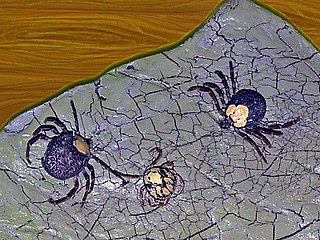
Amblyomma rhinocerotis is a species of tick belonging to the family Ixodidae. [2][3][4] The species was first discovered in 1778 in the southern parts of Africa; however it disappeared in the 1970s before reappearing again in 2017 in the northern parts of Africa. It is primarily a rhino parasite. [5]
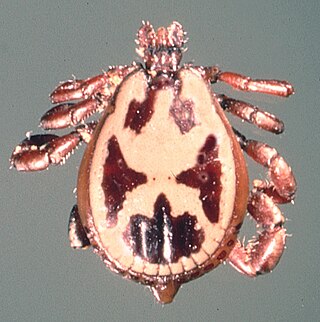
The zebra tick or yellow back tick is a species of hard tick. It is common in the Horn of Africa, with a habitat of the Rift Valley and eastward. It feeds upon a wide variety of species, including livestock, wild mammals, and humans, and can be a vector for various pathogens. The adult male has a distinctive black and ivory ornamentation on its scutum.
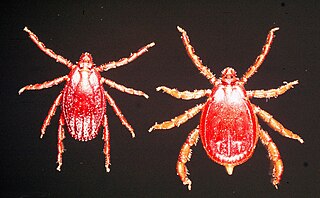
Rhipicephalus appendiculatus, the brown ear tick, is a hard tick found in Africa where it spreads the parasite Theileria parva, the cause of East Coast fever in cattle. The tick has a three-host life-cycle, spending around 10% of its life feeding on animals. The most common host species include buffalo, cattle, and large antelope, but R. appendiculatus is also found on other animals, such as hares, dogs, and warthogs.
Rhipicephalus gertrudae is a species of tick in the family Ixodidae. The specific epithet honors South African parasitologist Dr. Gertrud Theiler. The species was first circumscribed by Dr. Brouria Feldman-Muhsam.
Brouria Feldman-Muhsam was an Israeli medical entomologist and parasitologist known for her pioneering work with mites and ticks. After earning her Teaching Certificate at Levinsky College of Education in Tel-Aviv in 1935, Feldman-Muhsam enrolled in the University of Geneva in Switzerland and completed her licence ès sciences in biology there in 1937, qualifying her for doctoral studies. She returned to Mandate Palestine in 1937 and earned her Doctor of Philosophy degree in Medical Entomology at the Hebrew University of Jerusalem, graduating in 1942.
Ixodes siamensis is an ixodid tick that is parasitic on mammals in Thailand.
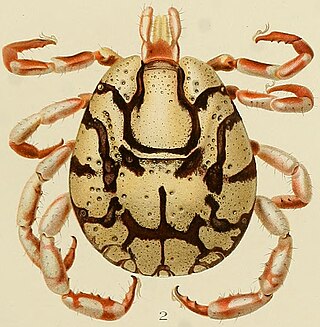
Cosmiomma is a genus of ticks first discovered by Paul Schulze in 1919. It is monospecific, being represented by the single species Cosmiomma hippopotamensis. It was first described in 1843 by Henry Denny from specimens collected from a hippopotamus in Southern Africa, and has been called "one of the most unusual, beautiful, and rare tick species known to the world."

Natalia Aleksandrovna Filippova was a world authority on the taxonomy of mites and especially ticks. Her monographs on the identification, morphology, development, distribution and behaviour of the family Argasidae and the sub-families of Ixodinae and Amblyomminae are standard works on these important vectors of disease.













